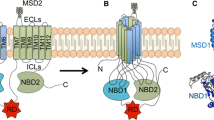Abstract
Defects in protein folding constitute the basis of many genetic diseases: cystic fibrosis, alpha-1 antitrypsin deficiency, familial hypercholesterolemia, and congenital nephrogenic diabetes insipidus, to name but a few (see Table 1 for a complete list). In each of these, point mutations or deletions result in a protein product that fails to achieve its properly folded state. For example, in the case of the cystic fibrosis transmembrane conductance regular protein (CFTR), the most common mutation in patients is the loss of a single phenylalanine residue (at position 508) within a polypeptide of 1480 amino acids (1). This seemingly minor alteration results in the newly synthesized CFTR protein being unable to fold properly and traffic to its proper destination at the plasma membrane (2). Instead, the vast majority of the mutant protein is retained at an early point in its maturation pathway and over time is targeted to a degradative pathway (3-5). As a consequence, cells expressing the mutant protein are unable to transport chloride ions across the plasma membrane in response to rises in intracellular cAMP levels.
Access this chapter
Tax calculation will be finalised at checkout
Purchases are for personal use only
Similar content being viewed by others
References
Kerem, B., Rommens, J. M., Buchanan, J. A., Markiewicz, D., Cox, T. K., Chakravarti, A., Buchwald, M., and Tsui, L. (1989) Identification of the cystic fibrosis gene: genetic analysis. Science 245, 1073–1080.
Cheng, S. H., Gregory, R. J., Marshall, J., Paul, S., Souza, D. W., White, G. A., O’Riordan, C. R., and Smith, A. E. (1990) Defective intracellular transport and processing of CFTR is the molecular basis of most cystic fibrosis. Cell 63, 827–834.
Ward, C. L. and Kopito, R. R. (1994) Intracellular turnover of cystic fibrosis trnasmembrane conductance regulator. J. Biol. Chem. 269, 25,710–25,718.
Jensen, T. J., Loo, M. A., Pind, S., Williams, D. B., Goldberg, A. L., and Riordan, J. R. (1995) Multiple proteolytic systems, including the proteasome, contribute to CFTR processing. Cell 83, 129–135.
Ward, C. L., Omura, S., and Kopito, R. R. (1995) Intracellular turnover of cystic fibrosis transmembrane conductance regulator: inefficient processing and rapid degradation of wild-type and mutant proteins. Cell 83, 121–127.
Denning, G. M., Anderson, M. P., Amara, J. F., Marshallo, J., Smith, A. E., and Welsh, M. J. (1992) Processing of mutant cystic fibrosis transmembrane conductance regulator is temperature sensitive. Nature 358, 761–764.
Drumm, M. L., Wilkinson, D. J., Smit, L. S., Worrell, R. T., Strong, T. V., Frizzell, R. A., Dawson, D. C., and Collins, F. S. (1991) Chloride conductance expressed by ΔF508 and other mutant CFTRs in Xenopus oocytes.Science 254, 1797–1799.
Hawthorne, D. C. and Friis, J. (1964) Osmotic-remedial mutants. A new classification for nutritional mutants in yeast. Genetics 50, 829–839.
Russell, R. R. B. (1972) Temperature-sensitive osmotic remedial mutants of Escherichia coli. J. Bact. 112, 661–665.
Singer, M. A. and Lindquist, S. (1998) Multiple effects of trehalose on protein folding in vitro and in vivo. Mol. Cell 1, 639–648.
Brown, C. R., Hong-Brown, L. Q., Biwersi, J., Verkman, A. S., and Welch, W. J. (1996) Chemical chaperones correct the mutant phenotype of the DF508 cystic fibrosis transmembrane conductance regulator protein. Cell Stress Chaperones 1, 117–125.
Sato, S., Ward, C. L., Krouse, M. E., Wine, J. J., and Kopito, R. R. (1996) Glyc-erol reverses the misfolding phenotype of the most common cystic fibrosis mutation..J. Biol. Chem. 271, 635–638.
Tatzelt, J., Prusiner, S. B., and Welch, W. J. (1996) Chemical chaperones interfere with the formation of scrapie prion protein. EMBO J. 15, 6363–6373.
Brown, C. R., Hong-Brown, L. Q., and Welch, W. J. (1997) Correcting temperature-sensitive protein folding defects. J. Clin. Invest. 99, 1432–1444.
Tamarappoo, B. K. and Verkman, A. S. (1998) Defective aquaporin-2 trafficking in nephrogenic diabetes insipidus and correction by chemical chaperones. J. Clin. Invest. 101, 2257–2267.
Yang, D., Yip, C. M., Huang, T. H. J., Chakrabartty, A., and Fraser, P. E. (1999) Manipulating the amyloid-β aggregation pathway with chemical chaperones. J. tBiol. Chem. 274, 32,970–32,974.
Burrows, J. A. J., Willis, L. K., and Perlmutter, D. H. (2000) Chemical chapezones mediate increased secretion of mutant alpha-1-antitrypsin Z: a potential pharmacological strategy for prevention of liver injury and emphysema in alpha-1-antitrypsin deficiency. Proc. Natl. Acad. Sci. USA 97 1796–1801.
Gekko, K. and Timasheff, S. N. (1981) Mechanism of protein stabilization by glycerol: preferential hydration in glycerol-water mixtures. Biochemistry 20, 4667–4676.
Somero, G. N. (1986) Protons, osmolytes, and fitness of internal milieu for protein function. Am. J. Physiol. 251 R197–R213.
Schein, C. H. (1990) Solubility as a function of protein structure and solvent components. Bio/Technology 8, 308–316.
Burg, M. B. (1995) Molecular basis of omotic regulation. Am. J. Physiol. 268, F983–F996.
Author information
Authors and Affiliations
Editor information
Editors and Affiliations
Rights and permissions
Copyright information
© 2002 Humana Press Inc.
About this protocol
Cite this protocol
Howard, M., Welch, W.J. (2002). Manipulating the Folding Pathway of ΔF508 CFTR Using Chemical Chaperones. In: Skach, W.R. (eds) Cystic Fibrosis Methods and Protocols. Methods in Molecular Medicine™, vol 70. Humana Press. https://doi.org/10.1385/1-59259-187-6:267
Download citation
DOI: https://doi.org/10.1385/1-59259-187-6:267
Publisher Name: Humana Press
Print ISBN: 978-0-89603-897-4
Online ISBN: 978-1-59259-187-9
eBook Packages: Springer Protocols




